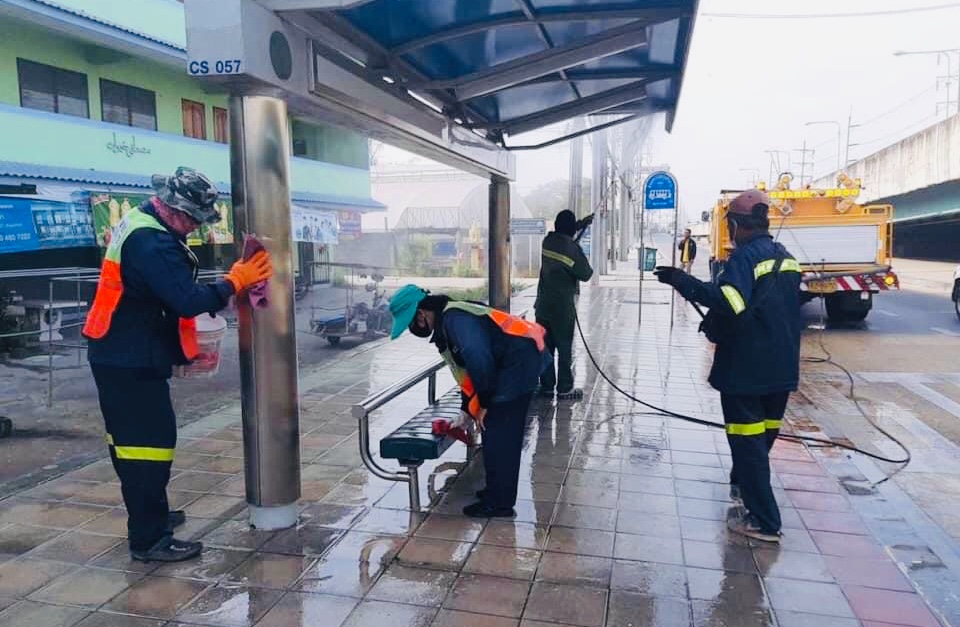The capital has been hit hard by haze today with the maximum PM 2.5 concentration levels in 24 hours being over 100 micrograms per cubic meter, defined as the hazardous threshold, while other parts of the country except the South have also felt the air pollution following the effects of the ongoing air inversion
The Pollution Control Department (PCD) has reported the sharp increase of haze caused by PM 2.5 in the capital today, of which its maximum concentration being beyond the hazardous threshold defined in the national agenda.
The department said the fine dust particles in the air in Bangkok were measured at between 44 to 111 micrograms per cu m, which means almost all of its areas have been blanketed by the haze, with the levels that start to “affect” health.
The PM 2.5 safety limit within 24 hours is set at no more than 50 micrograms per cu m. Anything beyond that is considered as the levels that will “start to affect health” and public members will be warned against outdoor exposure.
Besides Bangkok, other parts of the country have also experienced high levels of PM 2.5 haze today. The department said PM 2.5 concentration levels in the North today were between 31 to 74 micrograms per cu m, prompting eight areas in the region to have haze beyond the limit.
In the West and the East, PM 2.5 concentration levels were around 19-82 micrograms per cu m, and 34-56 micrograms per cu m, prompting almost all of the areas in these two regions to be choking with haze beyond the limit.
In the Northeast, PM 2.5 concentration levels were between 32 -97 micrograms per cu m, prompting at least five areas to become critical with choking haze.
However, based on its air quality modelling, the department expects that the situation would improve over the next few days as the air inversion would become less tense, with winds blowing more.
The air inversion
The country is experiencing the inversion, but in the next few days, the phenomenon is expected to become less tense, prompting winds to blow and the haze disperses.
The Bangkok Metropolitan Administration said it has been trying hard to reduce sources of the pollution, mainly from incomplete diesel-based engine combustion, by screening trucks travelling into the city. However, it has also contributed the cause of the poor air quality to the air inversion.
While the city is busy with suppressing sources of the air pollution in the city, the Ministry of Natural Resources and Environment as well as the PCD have been attempting to suppress the sources of haze in the North, which is considered as being critical annually.
This year, the ministry has introduced some initiatives to convince the locals there to help in fuel management by introducing some economic incentives for helping collect forest biomass materials and farm residues in advance to reduce fuels before forest fires strike during a dry season.
It has coordinated with the Interior Ministry as well as governors nationwide via video conference yesterday, asking them to implement the ad-hoc air pollution resolution plan approved by the Cabinet in November last year, which focuses especially on areas with regular forest fires in the North.
This includes collection of fuel materials in advance and scheduled burning to create fire buffers, which incorporates local participation.
Environment Minister Varawut Silpa-archa said his ministry would act as a supporter of the efforts by providing supportive data collected principally by the PCD and agencies under its supervision in the areas.
Thailand has been experiencing PM 2.5 haze seriously over the past few years since it first came up with better air pollution measurements, which exposed exceeding levels of dust particles that are harmful to people’s health like PM 2.5 both in the capital and other regions.
Since, the issue has been addressed as a national agenda, which directs comprehensive planning aimed to tackle the sources of the air pollution, which are different among regions.
For instance, in the capital, the main sources of the haze are incomplete combustion of car engines, especially diesel-based vehicles, intensive construction, as well as pre-harvest burning of farm leftovers in provinces in the Central Plain. In the North, on the other hand, the main sources of the pollution are farm clearing and forest burning.
The situation is often exacerbated by bad weather created by an air inversion, under which a warmer air overlays the cold air and acts as a lid while the air underneath becomes stagnant, thus trapping the pollution below.
Recently, locals in the North especially in Chiang Mai have tried to come up with changes in work structure and plans so that the situation is dealt with better. They have proposed local organisations act as the central coordinating bodies, rather than waiting for agencies in Bangkok to act for the problem further away.
This is also part of the decentralization of power, under which forest fire control is being transferred to local authorities and organisations. But they are being stuck with limited budgets, seen as among the critical challenges in resolving the haze problem.
Indie • in-depth online news agency
to “bridge the gap” and “connect the dots” with critical and constructive minds on development and environmental policies in Thailand and the Mekong region; to deliver meaningful messages and create the big picture critical to public understanding and decision-making, thus truly being the public’s critical voice


